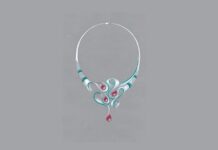Words by Steve Beckett, client services director at PushON, an award-winning full-service eCommerce agency
Shopping directly through social media, making online shopping easier and more seamless than ever, has seen tremendous growth in the past year and is rapidly changing the face of eCommerce as we know it.
Given this growth, as well as Instagram head Adam Mosseri having recently laid out his long-term vision to “ramp up” the platform’s retail offering, it is clear that social commerce is here to stay, and retailers can no longer afford to neglect social media as a shopping platform.
So, how can jewellers take full advantage of the social commerce boom?
Great product imagery is key
Particularly in the jewellery sector – an inherently visual industry – the power of effective product imagery cannot be understated. Combining this with shoppable features on visually-led social networks such as Pinterest’s buyable pins, or Instagram Checkout, means that jewellery retailers can reach, engage and convert customers far earlier in the buying journey than they could previously.
To this end, jewellery businesses should ensure that any product images posted to their social channels are at least 72 dpi and around 1,000px x 1,000px. In the absence of a physical product to touch and try on, it’s also important for images to give consumers as much of an idea of the product as possible to encourage conversions.
Some great ways to do this include showing the product from multiple angles, as well as including “lifestyle” shots of pieces being worn by a model (rather than against a blank background).
Pay attention to social feeds
Jewellers should also consider exactly how their social feeds are curated.
While social networks often allow businesses to include multiple shoppable tags in each post – meaning they can promote more than one product – over-use of this can make feeds look cluttered and unattractive. This can fracture users’ attention, disengaging them and possibly making them click away in favour of a competitor’s feed. Instead, have one product in focus and consider posting more often to maximise engagement.
Jewellers should also pay attention to how their entire feed is laid out. This means arranging it so that posts with a similar background, or complementary project lines, sit next to each other so that the feed appears to “flow” from one post to the next, to appeal to shoppers browsing down the feed. Tiffany & Co does this particularly well.
Don’t neglect your eCommerce site
Despite the rise of social commerce, direct in-app shopping is still relatively rare, with most social shopping methods directing shoppers to the retailer’s site. An optimised eCommerce site – that, crucially, loads quickly – therefore remains essential.
Given that customers are often funnelled directly from social media to the checkout page, particular attention should be paid to this area – especially considering that overly-long and complicated checkout processes are a common cause of shopping cart abandonment.
Reducing the number of form fields required for checkout and payment and removing any fields that aren’t absolutely necessary for customers to complete their purchases, can boost conversions. Showing customers which stage of the checkout they’re at with a progress indicator can also reduce frustration and abandonment.
Overall, social commerce is only becoming more popular with shoppers and, as major brands continue to invest in this space, it’s worth jewellers preparing themselves now to avoid being left behind in the coming months.
New Source : professionaljeweller
Disclaimer: This information has been collected through secondary research and TJM Media Pvt Ltd. is not responsible for any errors in the same.




























